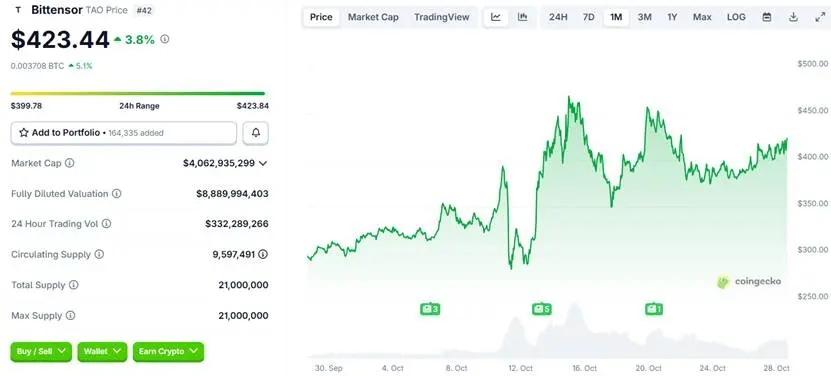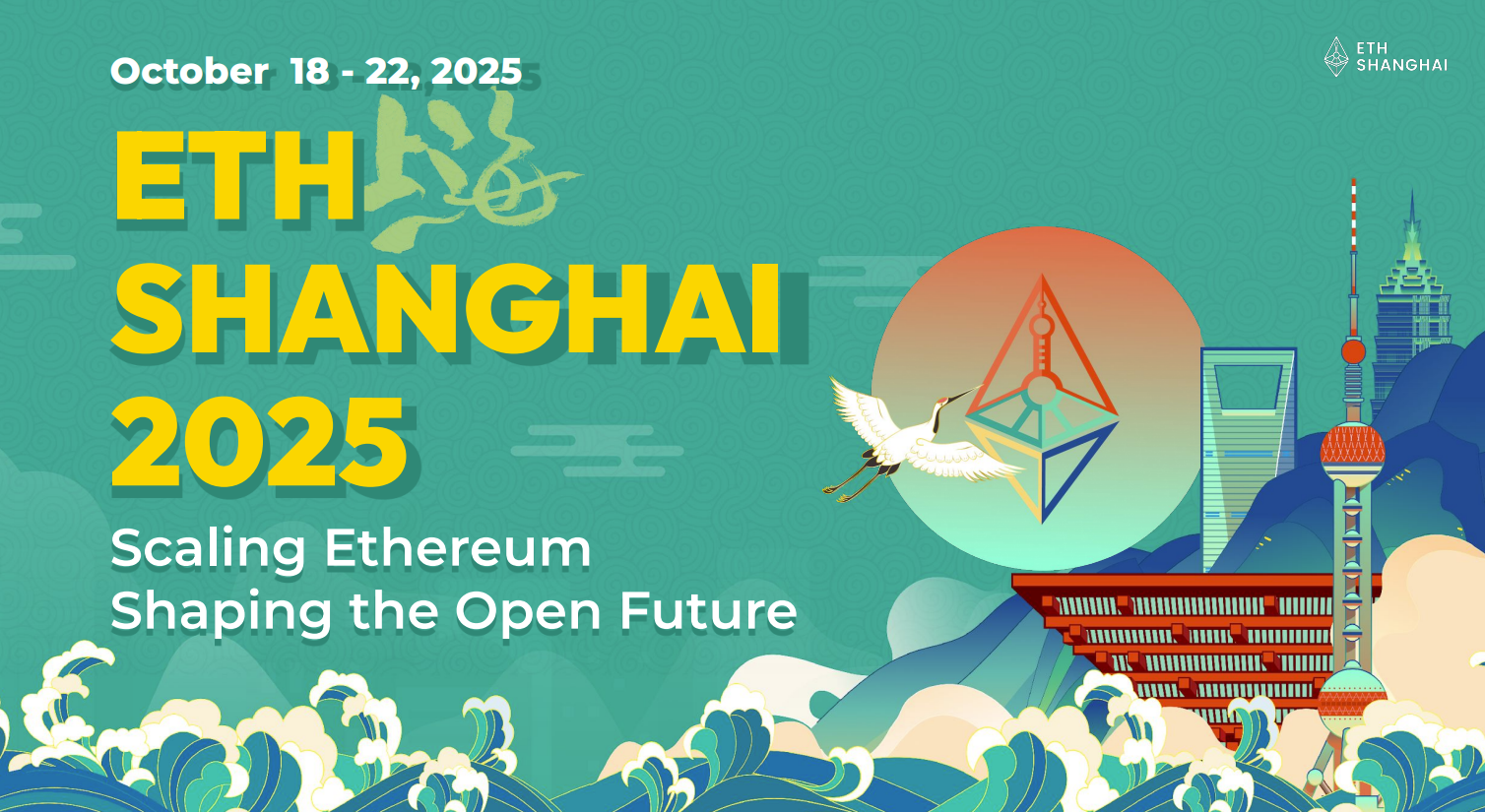Guest: Jacob Robert Steeves, Founder of Bittensor
Interview: Zhou & Chili, ChainCatcher
In recent years, decentralized artificial intelligence, as a cutting-edge field integrating blockchain and AI technologies, has attracted the attention of the global technology community. Bittensor (TAO), as an open-source protocol, applies a Bitcoin-style "mining incentive" mechanism to AI computing, organizing multiple subnets such as inference and training on the blockchain to compete with suppliers and receive rewards based on their contributions.
According to CoinGecko data, Bittensor's token TAO was listed on exchanges in March 2023. As of press time, its price was $423, with a market capitalization of approximately $4 billion, ranking 42nd among cryptocurrencies. Recently, TAO Synergies Inc., the company behind TAO, announced the completion of an $11 million private funding round, with investors including TAO strategist James Altucher and Grayscale's parent company, DCG.

In this ChainCatcher interview, we had the privilege of speaking with Jacob, the founder of Bittensor, to explore his technological vision, his journey from Google to entrepreneurship, and how Bittensor breaks down the barriers of traditional AI through "incentivized computing".
From Google to decentralized AI: Bittensor applies cryptocurrency mining to AI.
ChainCatcher : In recent months, we've noticed Bittensor (TAO) generating significant attention in the US and rapidly gaining traction in Asian communities. We hope this conversation will help more readers understand Bittensor and your own thoughts on the future of decentralized AI. Let's start by talking about your background. Many readers know you worked as a software engineer at Google. Why did you leave Google to start your own business? What had the biggest impact on you during that experience?
Jacob : I studied mathematics and computer science at Simon Fraser University in Vancouver, Canada. After graduating, I worked for a DARPA contractor working on brain-computer interface chips. My mentor (who was also the company founder) was an early Bitcoin supporter. He introduced me to concepts such as "energy/thermodynamics computing" and helped me truly understand Bitcoin.
Since 2015, I have been deeply involved in both Bitcoin and AI. These two things are naturally compatible because the core of AI is the study of feedback loops (backpropagation, genetic algorithms, reinforcement learning, etc.), while Bitcoin is the first programmable economic feedback loop. After that, I went to Google to work as a machine learning engineer and developed Bittensor in my spare time until I decided to devote myself to Bittensor full-time in 2018, and the mainnet was launched in 2021.
During my time at Google, I witnessed the publication of the paper "Attention Is All You Need" (Transformer), which propelled the exponential development of large models like GPT. I also learned a great deal about distributed machine learning practices from frontline teams, such as parameter servers, model parallelism, and data parallelism—experiences that were crucial to building the computational architecture for Bittensor later on.
ChainCatcher : Before we continue, could you briefly introduce Bittensor?
Jacob : Absolutely. Bittensor is an open protocol that applies Bitcoin-style mining mechanisms to AI: we use programmable economic incentives to organize distributed computing power, models, data, and applications into a fair market. Bittensor is a blockchain with its native token TAO, running approximately 128 subnets that compete collaboratively for different tasks such as inference, training, reinforcement learning, code proxy, storage, and prediction/trading signals. AI is essentially a computational problem; Bitcoin has proven that "incentives + competition" can effectively coordinate distributed resources, and we are simply transferring this primitive to intelligent production.
From the user's perspective, developers can initiate or join subnets, contribute models and computing power, and receive continuous incentives based on performance; demanders can purchase services such as inference, computing power, AutoML, or prediction signals through the network. Simply put, Bittensor transforms the "miner-reward-consensus" paradigm into "useful AI supply-market reward-network consensus".
Entering the world of Chinese developers: the most competitive environment and new sources of supply
ChainCatcher : Is this your first time in China? Why did you choose this time to do your speaking tour in China?
Jacob : This is my first time. I currently live in Peru and have never done an overseas tour before. I came to China specifically to discuss Bittensor. First of all, Bittensor applies Bitcoin mining to AI, and China is one of the fastest-growing, and perhaps even the most powerful, countries in the global artificial intelligence field. When Bitcoin mining was legal, China accounted for more than 50% of the computing power, and it still produces 90% of the world's chips today.
I have great respect for China's technical capabilities in these network constructions, and I hope that more Chinese developers can participate in the construction of the Bittensor network to help us expand its scale.
Bittensor is a decentralized, permissionless, and transparent open network that allows for fair participation from any region, providing a meaningful counterbalance to the current highly centralized AI infrastructure. We have already demonstrated its feasibility in several areas: bringing GPU resources and model services to the market through subnets, and competing with centralized solutions in terms of price and efficiency. Our goal in China is to implement these approaches within a larger developer ecosystem.
ChainCatcher : What key messages do you hope to convey to developers and investors in Asia during this trip? Are there any Chinese projects or communities that impressed you?
Jacob : Yes. We often hear this in Bittensor: when Chinese miners enter a subnet, the competition immediately becomes much fiercer, to the point that many who were already there choose to leave—this is actually entirely expected, because the intensity of competition in China is truly astonishing. From the organization and training methods of universities, you are one of the most competitive groups in the world, so I think China and Bittensor are a natural fit.
My purpose in coming here is to convey this message: This is a brand-new and fair economic platform where Chinese engineers, builders, and miners can make truly productive contributions—and in a transparent and fair manner. For example, Affine, one of the largest subnets on Bittensor, is being built by Chinese developers and is becoming one of the most competitive mechanisms on the entire network. I hope to encourage more teams like this to join, because the level of engineering here is truly exceptional, almost unparalleled.
ChainCatcher : What are your thoughts on the unique positions of China, Hong Kong, and Singapore in Web3 and AI?
Jacob : Currently, companies in China, Singapore, and East Asia are leading the trend of open-source AI. Top open-source models like DeepSeek originated from Chinese teams; Hong Kong and Singapore are more flexible in terms of compliance and capital, facilitating industrialization and cross-border collaboration. Overall, Asia is pushing "open models + engineering implementation" to the forefront, a combination that decentralized AI desperately needs. In addition, top Chinese universities such as Peking University and Tsinghua University have made significant contributions to academic and knowledge advancement.
ChainCatcher : You just mentioned that Bittensor has about 128 subnet projects. Could you talk about resource allocation or the distribution of engineers?
Jacob : The top three subnets (Subnet Ecosystem Projects) are all built by teams in China, which I think is very significant. Bittensor is an anonymous platform, but it's certain that a considerable number of Asian teams and computing power are connected. For example, Limium is a top-level subnet providing GPU resources; it creates a permissionless marketplace where anyone can contribute GPU computing power and access GPU resources over the network. Many Chinese miners have contributed these chips (we can see from the IP addresses of these machines that they are indeed located in Asia), and we are bringing these resources to the global market.
ChainCatcher : Have you been in contact with any investment institutions? There should be many investment funds or companies interested in Bittensor.
Jacob : Yes, we often receive inquiries from investors who want to participate and buy TAO. However, I'm not directly in charge of these matters; I'm just an engineer. Bittensor's network is open, and the market is liquid. Therefore, we recommend that everyone participate directly on the TAO secondary market because we believe that's the fairest way, allowing everyone to enter the market on an equal footing. In fact, investment firms frequently contact us, but we prefer that everyone participate in the market fairly.
ChainCatcher : Is there any possibility of future collaboration between Bittensor and traditional internet giants (such as OpenAI, Alibaba, Baidu, etc.)?
Jacob : Yes, it's possible, but it depends on whether our philosophies align. Some centralized labs in the US are unlikely to be very interested; they prefer consolidation and control, while we emphasize openness and permissionlessness. Conversely, more open teams like DeepSeek, Kimi, and Moonshot can connect resources to Bittensor, launch subnets on the network and monetize them, and also consume network resources. I think it's just a matter of time: either we cooperate, or they adopt our approach to decentralized training. If we can work with Moonshot to achieve truly decentralized training, we would be very happy to accept it.
Bittensor's underlying principle: using cryptoeconomic incentives for artificial intelligence research.
ChainCatcher : You recently mentioned on X that "Crypto + AI" is a superficial statement; the real key is incentive computing. Many people understand Bittensor as an "AI model aggregator," but you seem to emphasize it more as an "incentive network." Could you explain to our readers: What is the biggest difference between Bittensor and traditional aggregation platforms? What exactly does its "decentralization" change?
Jacob : The understanding of "AI model aggregator" is incorrect. The core of Bittensor is to embed "programmable incentives" into the AI learning process: whoever provides more useful inference, training, or tools receives more rewards, which is completely different from "piling up models together." The breakthroughs in AI over the past 15 years have come from adaptive learning of feedback/rewards (such as backpropagation and RL). What we are doing is directly programming currency and incentives into this mechanism, using market signals to continuously optimize supply and quality.
The significance of "decentralization" lies in permissionless entry and resistance to single points of failure. In other words, any individual or team can go online to participate in the competition on a subnet. Good supply is amplified through incentives, while poor supply is naturally eliminated. At the same time, resource distribution and routing elasticity make the service more resilient to single points of failure. However, our goal is not "decentralization for the sake of decentralization," but to enable incentives to drive the scaling of useful computing—this is the fundamental difference between Bittensor and traditional aggregation platforms.
However, the so-called Crypto + AI is just applying cryptocurrency to AI, or applying AI to crypto. This idea does not touch the core of what we are doing. What we are actually doing is using crypto-economic incentives to conduct artificial intelligence research.
ChainCatcher : AWS experienced a large-scale outage a few days ago, causing many AI services to stop operating. What's your interpretation of this?
Jacob : I believe this incident demonstrates one of the values of decentralization—its resilience to single points of failure. Bittensor didn't crash because we rely on decentralized resource allocation, which is one of our strengths. However, this incident also proves that many so-called decentralized ecosystems aren't truly decentralized, as some projects genuinely couldn't recover after crashing. Decentralization isn't Bittensor's core objective. Of course, we use censorship-resistant mechanisms in our core technology, but this isn't Bittensor's fundamental driving force.
Economy and Vision: TAO Halving Cycle, Protocol Revenue Sources, Forecast Markets and Five-Year Goals
ChainCatcher : 2025 marks the first halving cycle for TAO. What impact do you think this halving will have on the behavior of developers and validators in the ecosystem?
Jacob: In reality, I think the only impact of the halving on Bittensor is that the supply will tighten. But this will not affect the network's basic incentive mechanism; the network still has huge economic incentives to encourage developers to build on the platform.
ChainCatcher : Where does the revenue of the Bittensor protocol layer mainly come from?
Jacob : Primarily comes from selling inference, computing power, AutoML (automated machine learning), and selling signals to the prediction market.
ChainCatcher : You just mentioned prediction markets. How do you view the current status and business model of prediction markets in the Web3 ecosystem?
Jacob : I think that's a great idea. If you're talking about Kalshi and Polymarket, I think they're one of the real fintech applications, the first of their kind to be applied to consumers at scale. It makes a lot of sense and profoundly changes the way people work.
ChainCatcher : Finally, let's talk about the vision for Bittensor. Looking five years from now, what headlines would you like to see about Bittensor? What is your vision for this application? How do you plan to execute it?
Jacob : The headline I most want to see, and the most important one, is: We've brought this technology to millions of users and are truly providing open, intelligent services globally, with the network continuously expanding and operating sustainably. We're already seeing the beginnings of this path: economically, we can outperform centralized providers in many scenarios with cost advantages, especially in inference. Currently, about 100,000 users are using our technology; the next step is not only to lead at the inference level but also to move towards the application layer.
Our goal is to serve billions of users globally. Take Ridges as an example: this is a large subnet on Bittensor, focusing on coding agents and optimized collaboratively by miners worldwide. A direct benefit of this approach is a significant price reduction : the network passively and continuously optimizes its cost-effectiveness—while some centralized products have service costs approaching $1000 per user, but subscription prices are limited to around $200, relying heavily on subsidies, we can reduce subscriptions to $10, with the network itself costing approximately $6. This kind of economic law of scale allows us to reach the entire world; centralized AI companies that don't adopt these underlying technological primitives will find it difficult to keep up in terms of performance, speed, and cost in the long run.
This is our core advantage. If we can consistently outperform them in these key dimensions, it will be very difficult for them to beat us in this competition; conversely, if we cannot do these things, then there is no point in even talking about it.
Similarly, Bitcoin's ability to outperform sovereign states or centralized systems at the network level stems from its use of correct technological primitives and mechanism design. Bittensor, of course, hasn't achieved this in all areas, but it has in some specific domains, and many people actually use Bittensor in their daily lives without realizing it.







